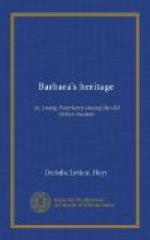Although they expected to find an old, worn-out city, yet only Mr. Sumner and Mrs. Douglas were quite prepared for the dilapidated carriages that were waiting to take them from the station to their hotels; for the almost deserted streets, and the general pronounced air of decadence. Even the Arno seemed to have lost all freshness, and left all beauty behind as it flowed from Florence, and was here only a swiftly flowing mass of muddy waters.
After having taken possession of their rooms in one of the hotels which look out upon the river, and having lunched in the chilly dining room, which they found after wandering through rooms and halls filled with marble statues and bric-a-brac set forth to tempt the eyes of travellers, and so suggestive of the quarries in which the neighboring mountains are rich, they started forth for that famous group of sacred buildings which gives Pisa its present fame.
They were careful to enter the Cathedral by the richly wrought door in the south transept (the only old one left) and, passing the font of holy water, above which stands a Madonna and Child designed by Michael Angelo, sat down beneath Andrea del Sarto’s St. Agnes, and listened to Mr. Sumner’s description of the famous edifice.
He told them that the erection of this building marked the dawn of mediaeval Italian art. It is in the old basilica style, modified by the dome over the middle of the top. Its columns are Greek and Roman, and were captured by Pisa in war. Its twelve altars are attributed to Michael Angelo (were probably designed by him), and the mosaics in the dome are by Cimabue. They wandered about looking at the old pictures, seeking especially those by Andrea del Sarto, who was the only artist familiar to them, whose paintings are there. They touched and set swinging the bronze lamp which hangs in the nave, and is said to have suggested to Galileo (who was born in Pisa), his first idea of the pendulum.
Then, going out, they climbed the famous Leaning Tower, and visited the Baptistery, where is Niccolo Pisano’s wonderful sculptured marble pulpit.
Afterward they went into the Campo Santo, which fascinated them by its quaintness, so unlike anything they had ever seen before. They thought of the dead reposing in the holy earth brought from Mount Calvary; looked at the frescoes painted so many hundreds of years ago by Benozzo Gozzoli, pupil of Fra Angelico; at the queer interesting Triumph of Death and Last Judgment, so long attributed to Orcagna and now the subject of much dispute among critics; and then, wearied with seeing so much, they went into the middle of the enclosure and sat on the flagstones in the warm sun amid the lizards and early buttercups.
The next afternoon they went to Siena, and arrived in time to see, from their hotel windows, the sunset glory as it irradiated all that vast tract of country that stretches so grandly on toward Rome. Here they were to spend several days.




